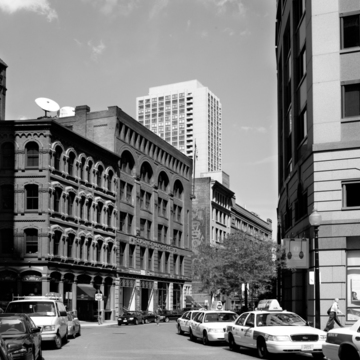The Chadwick Lead Works was originally located in the center of the iron and hardware trade district. The Romanesque facade is dominated by four three-story arches and topped by a row of closely spaced rectangular clere-story windows, ornamented with terra-cotta. The first story has granite piers and a cast-iron lintel. Topped by carved griffins, the company name in terra-cotta adorns the building above the second story, as well as on the tall, equally Romanesque tower at the rear corner of the building. The tower was used for manufacturing lead shot by dropping molten lead from the top, which formed into balls and cooled as it fell. The company also manufactured castlead products such as pipe and solder. (Later zoning prevented downtown manufacturing.) The Chadwick Lead Works had a relatively short life in the lead business, however, since it was taken over by another company in 1902. The adjacent National Whiting Building (1875, George H. Young, NRD) at 172–174 High Street, which also originally served the iron and hardware trade, is a fine example of Italianate commercial architecture with a cast-iron first story.
You are here
Chadwick Lead Works
If SAH Archipedia has been useful to you, please consider supporting it.
SAH Archipedia tells the story of the United States through its buildings, landscapes, and cities. This freely available resource empowers the public with authoritative knowledge that deepens their understanding and appreciation of the built environment. But the Society of Architectural Historians, which created SAH Archipedia with University of Virginia Press, needs your support to maintain the high-caliber research, writing, photography, cartography, editing, design, and programming that make SAH Archipedia a trusted online resource available to all who value the history of place, heritage tourism, and learning.


